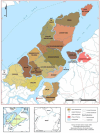Factors associated with functional health literacy and the quality of life of riverside residents served by the primary care network in the Brazilian amazon: a cross-sectional study
- PMID: 39701991
- PMCID: PMC11658385
- DOI: 10.1186/s12875-024-02684-y
Factors associated with functional health literacy and the quality of life of riverside residents served by the primary care network in the Brazilian amazon: a cross-sectional study
Abstract
Background: the riverside population lives in a vulnerable social situation, shaped by geographical, economic, social, and educational aspects that have repercussions on health literacy, the limitations of which can compromise Quality of Life. These specificities influence the actions of Primary Health Care, especially in the rural context. This study aimed to assess the factors associated with Functional Health Literacy and Quality of Life among riverside residents of the Brazilian Amazon who use Primary Health Care.
Methods: a cross-sectional study with 312 users of a riverside Family Health Team, using the Health Literacy Test, classified as adequate, limited, and inadequate, and the Study Short Form 12 Health Survey questionnaire, analyzing the physical and mental components in isolation. A theoretical model was built to assess the associations between sociodemographic and environmental variables and the Functional Health Literacy and Quality of Life outcomes. The Functional Health Literacy outcome was considered as two dichotomous variables (inadequate versus adequate; limited versus adequate), while the Quality of Life outcomes were considered as counts, with a Poisson distribution. Thus, a structural equation model was used to adjust the proposed theoretical model.
Results: there was a worsening in inadequate Functional Health Literacy, associated with females, aged over 40, elementary school education, living close to the health service, and using only a cell phone for communication. Factors that compromised physical Quality of Life: livelihood problems; inadequate literacy; age range 40-59; and having two children or more. And those that worsened mental Quality of Life: age over 40; having a family allowance; and being in control of their medication.
Conclusions: sociodemographic, environmental, and economic factors and adherence to medication by river communities have been shown to be associated with Health Literacy and Quality of Life. Knowing these implications is fundamental for health provision. These findings can support the formulation of strategies in health services to improve Health Literacy and Quality of Life.
Keywords: Health Literacy; Primary Health Care; Quality of Life; Rural Population Health; Socioeconomic Factors.
© 2024. The Author(s).
Conflict of interest statement
Declarations. Ethical approval and consent to participate: The study followed the guidelines of Resolution 466/2012 of the National Health Council/Ministry of Health, which regulates research with human beings in Brazil. Thus, it obtained institutional authorization from the Municipal Health Department of Abaetetuba and was approved by the Research Ethics Committee of the Undergraduate Nursing Course at the State University of Pará, under Opinion No. 4.517.829 of February 1, 2021. All participants signed the Free and Informed Consent Term (FICT), formally declaring their voluntary acceptance. Consent for publication: Not applicable. Competing interests: The authors declare no competing interests.
Figures



Similar articles
-
Health literacy and quality of life of riverine populations in primary health care.Rev Lat Am Enfermagem. 2025 Mar 14;33:e4440. doi: 10.1590/1518-8345.7402.4440. eCollection 2025. Rev Lat Am Enfermagem. 2025. PMID: 40105656 Free PMC article.
-
Association of physical performance and sarcopenia with use of health services in elderly people living in rural riverside areas in the Amazon: a cross-sectional study.Rural Remote Health. 2023 Oct;23(4):7957. doi: 10.22605/RRH7957. Epub 2023 Oct 8. Rural Remote Health. 2023. PMID: 37806667
-
Assessment of health literacy in the adult population registered to family medicine physicians in the Republic of Srpska, Bosnia and Herzegovina.Eur J Gen Pract. 2019 Jan;25(1):32-38. doi: 10.1080/13814788.2019.1571579. Eur J Gen Pract. 2019. PMID: 30794048 Free PMC article.
-
Contextual and individual factors associated with self-reported tooth loss among adults and elderly residents in rural riverside areas: A cross-sectional household-based survey.PLoS One. 2022 Nov 22;17(11):e0277845. doi: 10.1371/journal.pone.0277845. eCollection 2022. PLoS One. 2022. PMID: 36413557 Free PMC article.
-
Behavioural modification interventions for medically unexplained symptoms in primary care: systematic reviews and economic evaluation.Health Technol Assess. 2020 Sep;24(46):1-490. doi: 10.3310/hta24460. Health Technol Assess. 2020. PMID: 32975190 Free PMC article.
References
-
- Nutbeam D, Muscat DM. Health promotion glossary 2021. Health Promot Int. 2021;36(6):1578–98. - PubMed
-
- World Health Organization. Health Promotion Glossary of Terms 2021. Geneva: WHO; 2021. https://iris.who.int/handle/10665/350161.
-
- WHOQOL G. The World Health Organization Quality of Life Assessment (WHOQOL): position paper from the World Health Organization. Soc Sci Med. 1995; 41(10):1403–9. - PubMed
MeSH terms
LinkOut - more resources
Full Text Sources
Medical
